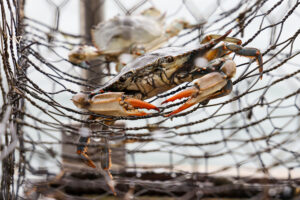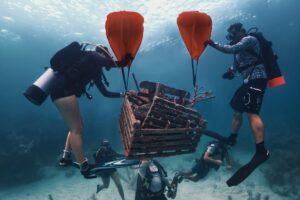by Patrick McGettigan | October 29, 2025
The second round of programmatic funding awarded by William & Mary’s Batten School & VIMS totals $1.8M in support of 13 projects focused on removing derelict fishing gear from coastal waters.

Lurking in the waters along our shorelines, a haunting presence is luring marine life to their untimely demise and trapping their spirits in an underwater purgatory. This isn’t the plot of a new Halloween blockbuster, it’s the unfortunate impact of derelict fishing equipment commonly known as “ghost traps.”
William & Mary’s Batten School of Coastal & Marine Sciences & VIMS has awarded $1.8 million to 13 organizations throughout the U.S. focused on the removal of derelict fishing gear, which poses a significant threat to the sustainability of coastal and marine environments and the fishing industries from which they originate. This is the second year of subawardees distributed through the National Fishing Trap Removal, Assessment and Prevention (TRAP) Program.
A scientific solution for a ghoulish problem

In the United States, commercial trap fisheries generate over $1 billion in annual revenue from seafood sales, referred to as landings. Each year, traps are lost due to vessel-gear interactions, storms and gear degradation. These “ghost traps” become inaccessible to fishermen but continue to function, resulting in mortality of both target and non-target species, habitat damage and reduced fishery landings. A 2016 report found that removing just 10% of derelict crab pots and lobster traps could result in an additional $831 million in global landings annually.
In 2023, the Batten School & VIMS was the recipient of an $8 million, four-year grant from the National Oceanic and Atmospheric Administration’s (NOAA) Marine Debris Program to administer the National TRAP Program. In addition to distributing approximately $1.5 million annually to fund regional cleanup efforts, the program has established a standardized national database to evaluate the environmental and economic benefits of the removal efforts and to inform future policies.
In its first year of funding, the TRAP Program awarded over $1.4 million to fund 11 projects. So far, the efforts have resulted in the removal of over 7,000 derelict traps totaling more than 300,000 pounds of debris. A number of projects are still recovering derelict traps, and removals in Louisiana are set to begin in February. Many other regional success stories have surfaced from these efforts.

“We are thrilled with the initial results from our inaugural TRAP Program recipients. Their success is a testament to the impact that locally-designed solutions can have on global issues,” said Kirk Havens, director of the Batten School & VIMS Center for Coastal Resources Management, which administers the TRAP Program under the direction of co-principal investigators Professor Donna Bilkovic and Associate Professor Andrew Scheld. “Our second round of recipients have demonstrated that same creativity, thoughtfulness and local community engagement in their project proposals, and we are proud to support them as they work for the benefit of their communities and marine ecosystems.”
This year, $1.8 million in grant funding will be distributed across 13 projects in Maine, Massachusetts, Rhode Island, New Jersey, Maryland, South Carolina, Florida, Washington and California. Recipients anticipate the removal of over 8,000 ghost traps and the creation of 195 jobs, mostly for commercial fishers.
Funding recipients will begin their cleanup efforts in January 2026 and will be required to submit standardized data on their progress. The data will be analyzed by the Policy Innovation Lab, a partnership between the Batten School & VIMS and the Carl Vinson Institute of Government at the University of Georgia, to explore drivers of derelict trap abundance, bycatch, and other ecological or economic variables. This information will help inform state and federal policy recommendations to improve derelict trap prevention and mitigation.
Visit the National TRAP Program website for additional information and statistics from first-round projects.
Who you gonna call? Ghost (trap) Busters!
The following projects were selected for funding through a national competitive grant process administered by the Batten School & VIMS:
